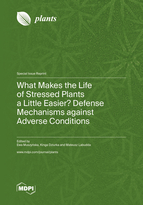What Makes the Life of Stressed Plants a Little Easier? Defense Mechanisms against Adverse Conditions
A special issue of Plants (ISSN 2223-7747). This special issue belongs to the section "Plant Physiology and Metabolism".
Deadline for manuscript submissions: closed (30 September 2022) | Viewed by 52019
Special Issue Editors
Interests: cell ultrastructure; plant anatomy and physiology; signaling molecules; abiotic stress mechanisms and adaptation; tissue culture
Special Issues, Collections and Topics in MDPI journals
Interests: biochemical and physiological markers of stress in plants especially hormonal regulation; polyamines; phenylpropanoids; carbohydrates; antioxidants; drought; alleviation of stress effects; in vitro cultures; seed dormancy; haploidization; embryogenesis; OMA (oat×maize addition); others related to the response of plants environmental stresses
Interests: molecular, biochemical, and physiological mechanisms of plant responses to pathogens and pests especially reactive oxygen and nitrogen species; enzymatic and non-enzymatic antioxidants; sugars as signaling molecules; regulation of proteolysis and nitrogen metabolism; additional research topics concern the plant abiotic stress especially metallic trace elements and mechanisms of combined stresses
Special Issues, Collections and Topics in MDPI journals
Special Issue Information
Dear Colleagues,
Plants experience a wide array of environmental stimuli, some of which, including a high concentration of heavy metals, salinity, extremes of temperature, water shortage, gradation of pathogens and pests, have a negative impact on their metabolism and growth. As generally motionless organisms, plants are unable to get away from such stressful conditions, and they, therefore, require various mechanisms to recognize and cope with the circumstances in which they find themselves. In the response to both biotic and abiotic stressors, fine adjustments in amino acids, proteins, and carbohydrate metabolism, the maintenance of redox balance as well as structural adaptation seem to be the basis of survival in harsh growing conditions. Furthermore, all defense responses require effective signaling involving different types of molecules. Among them, there is an urgent need for intensive research into transcription factors, important regulators of gene expression during plant growth and development under both optimal and stressful environmental conditions. An explanation of their roles in complex stress responses remains fragmentary. On the other hand, many different types of molecules, such as phytohormones or reactive oxygen–nitrogen–sulfur species, have the potential to act as priming agents or protectants, whose application constitutes a possible method against a range of stressors and provides intracellular acclimatization. Thus, considering the high interest in the multiple approaches to stress, the general concept of this Special Issue is to broaden and summarize the latest knowledge of the stress biology field. In particular, original and review papers related to structural, transcriptomics, metabolomics, proteomics, and other integrated stress aspects and its mitigation are welcome.
Dr. Ewa Muszyńska
Dr. Kinga Dziurka
Dr. Mateusz Labudda
Guest Editors
Manuscript Submission Information
Manuscripts should be submitted online at www.mdpi.com by registering and logging in to this website. Once you are registered, click here to go to the submission form. Manuscripts can be submitted until the deadline. All submissions that pass pre-check are peer-reviewed. Accepted papers will be published continuously in the journal (as soon as accepted) and will be listed together on the special issue website. Research articles, review articles as well as short communications are invited. For planned papers, a title and short abstract (about 100 words) can be sent to the Editorial Office for announcement on this website.
Submitted manuscripts should not have been published previously, nor be under consideration for publication elsewhere (except conference proceedings papers). All manuscripts are thoroughly refereed through a single-blind peer-review process. A guide for authors and other relevant information for submission of manuscripts is available on the Instructions for Authors page. Plants is an international peer-reviewed open access semimonthly journal published by MDPI.
Please visit the Instructions for Authors page before submitting a manuscript. The Article Processing Charge (APC) for publication in this open access journal is 2700 CHF (Swiss Francs). Submitted papers should be well formatted and use good English. Authors may use MDPI's English editing service prior to publication or during author revisions.
Keywords
- Abiotic and biotic stress
- Antioxidants
- Cell and systemic adaptation
- Multiple stressor effects
- Structural, metabolic, and genetic regulation
- ROS/RNS metabolism
- Signaling
- Transcription factors









